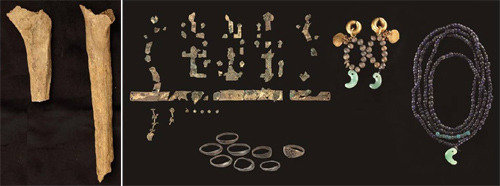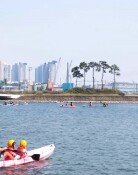Trace of temporary mortuary service discovered at Shilla tomb
Trace of temporary mortuary service discovered at Shilla tomb
Posted March. 16, 2017 07:15,
Updated March. 16, 2017 07:25

“Binjang” is an ancient Korean funeral ritual, which the corpse is enshrined in the mortuary for a certain period before burying. According to the Chinese classics such as The Book of Sui, records tell that Binjang was held for three years in Goguryeo and one year in Shilla, but no clear archeological evidence has been discovered until now. Therefore, if the recent opinion on Binjang at the ancient tombs in Imdang-dong is proven to be a historical fact, this will be the first evidence to showcase the ancient funeral service during the Shilla Dynasty.
Kim Dae-wook, a researcher at Yeungnam University Museum, has published his new analysis on the three human bones discovered at the “Joyeong EII-2” tomb near the tumulus in his article “Review of Possible Binjang in Shilla Ancient Tombs” presented at the Society of Ancient Tomb Culture. According to the analysis, it is estimated that the tomb filled with wooden coffin covered in underground receptacle beneath an aquifer was for the regional high-ranking Shilla officials buried in the early 6th century.
The tomb consists of main underground receptacle, which contained the deceased and their attendants buried with the owner of the coffin, along with the annex underground receptacle that contained various grave goods and ritual food.
When first excavated in 1988, only two human bones were discovered from the main underground receptacle. It was presumed that the head buried eastward was the tomb owner, while the westerly-faced corpses at the opposite side were the attendants. Still, questions remained unanswered. Immense amount of grave goods of Shilla elites including gilt bronze crowns and shoes, silver waistbands and rings were excavated from the mid-section of the tomb between human bones. However, the excavated origins of the bones and expensive ornaments did not match, despite the fact that they were “worn relics,” which gilt gold crowns and others were actually worn by the corpse during the burial.
The mystery was solved only recently by human bone experts. While bones excavated at the tomb were being resorted, another human bone was discovered. As the recently excavated remainders were only two thighbones, it seemed that researchers did not recognize as separate corpses. However, recent analysis results show that the newly discovered bones were predated than the existing 15-18 and 7-12 year-old bones. As a result, researchers pointed out that the gilt gold crowns and shoes belonged to someone else.
Then why did ancient Koreans bore the hassle of watching the corpse rot and held Binjang? According to Kim’s analysis, “(They) needed time to prepare vast amounts of grave goods and ritual foods.” As a matter of fact, a variety of ritual foods were found inside the annex Imdang-dong underground receptacle, including the meats of cows, boars, chickens, dogs, pheasants, Japanese crane, carp, apricot, peach, along with seafood such as yellow tail, red seabream, blowfish, shark, conch, gastropod, abalone, and pacific oysters.
Sang-Un Kim sukim@donga.com







